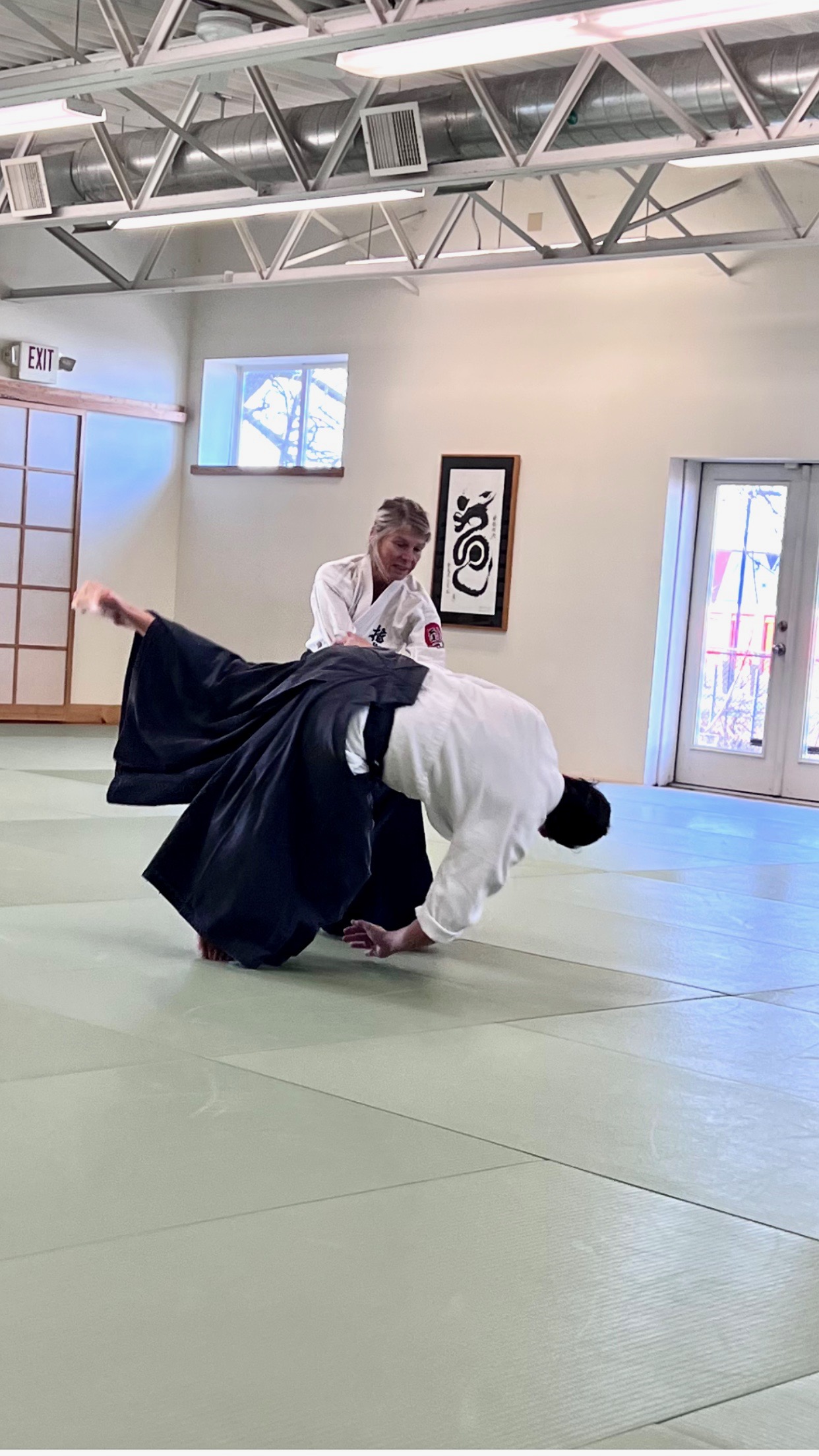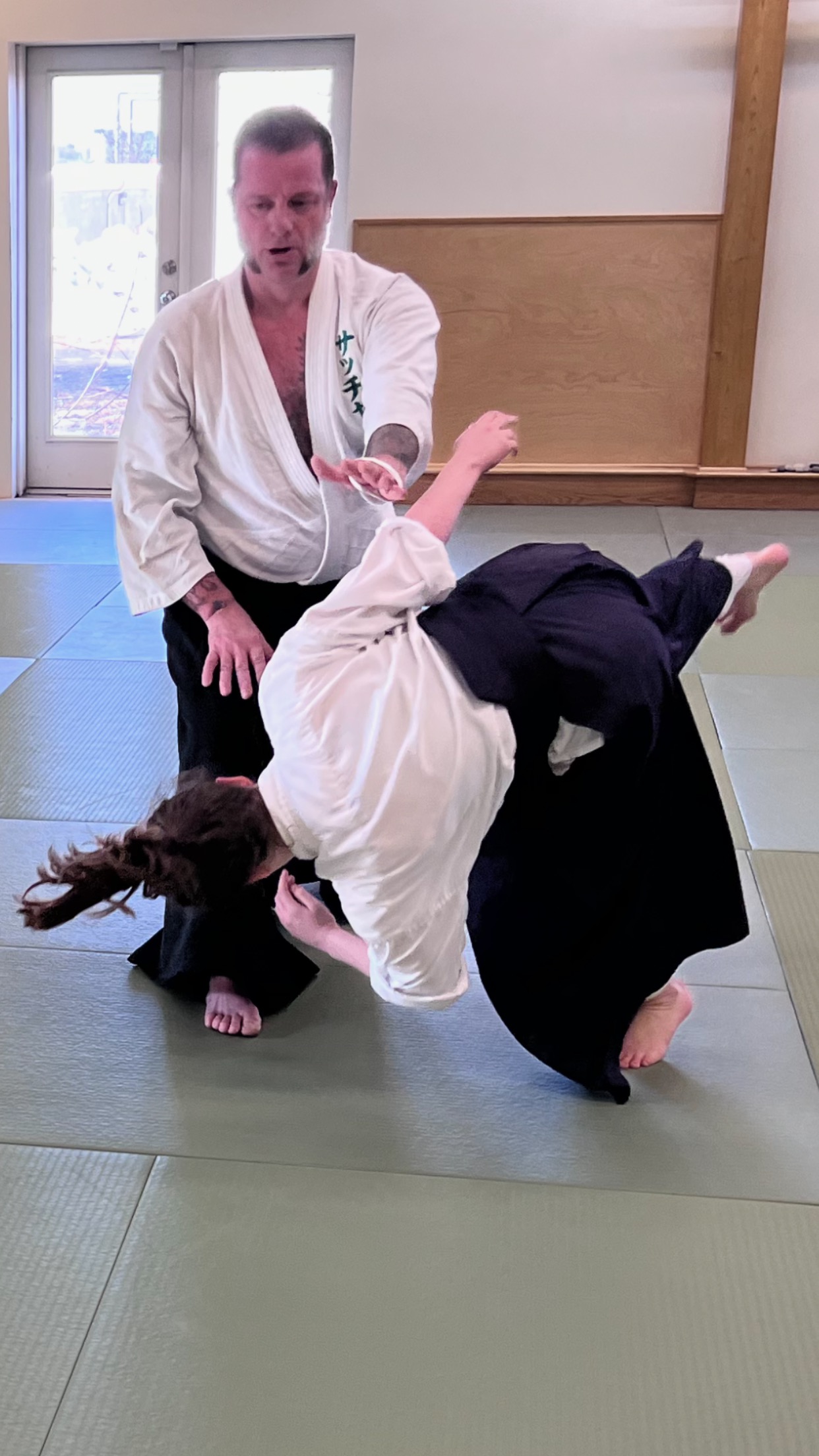By Ania Small Ph.D.

Chance are, that somewhere along your Aikido journey, you were told to “just relax”. If you are anything like me, hearing it made you instinctively tighten up. Relaxing on demand is not easy, especially when you are newer to the art.
Pointing out tension to beginners makes them feel frustrated. The same goes for non-verbal messages of shaking and dropping shoulders, as well as shoulder massages meant to help with relaxation. I’m not saying it never works, but the message does not have a high success rate. We want Aikido to become a self-rewarding activity we crave, rather than a tool for self-criticism.
Most of the time the advice to relax comes from the right place. The teacher or training partner tries to help, by pointing out the tension, hoping that the awareness of it will help it disappear. If it only was so easy. Most people initially get more tense when asked to relax, and that includes folks who voluntarily seek out relaxation and stress reduction programs. “Just relax” often has an opposite effect, leaving the advised feeling like they’re failing the most basic task. The issue is more with the effectiveness than the intention of the phrase.
Unfortunately, the advice to “just breathe” or “take a deep breath”, although mostly positive, might fall in the same category as “just relax” because it implies that we are not breathing or doing it correctly. It’s true that diaphragmatic breathing helps with relaxation, but it is a little more complicated than “just breathe”. Since breathing is mostly involuntary, and shallow breathing might be a signal of feeling unsafe, there are more factors involved. In addition, most people when asked to take a deep breath do a combination of raised shoulders, chest constriction and a wheeze. Asking someone to “just relax” or just breathe” while they are trying to figure out ten others things under pressure is not the most effective strategy.
This doesn’t mean we can’t talk about the importance of relaxed and natural movement and breath in Aikido as something to aspire to. I think it’s important as a goal and part of the big picture for the art, but it won’t be accomplished by pointing out tension in our fellow Aikido practitioners and students. I suggest we look for other ways of fostering relaxation.
Here are some ideas for alternative approaches:
– My Aikido friend, Terry Richmond, who works as a doula, helping women deliver babies, once told me she uses the word “release” instead of “relax”. I am sure most women in labor would not appreciate being told to “just relax”. Using the word “release” seems more positive. It suggests an activity (releasing), rather than the absence of one (tensing). In other words it is a positive suggestion. Sometimes, it might be more specific like “release your jaw”as a way to help with overall relaxation.
- Since most people don’t realize they are tense, we can use an equivalent of progressive muscle relaxation in Aikido practice. It could help bring awareness to the involuntary tension, and give us a method of regulating it. It would require first tensing muscles, and then releasing the tension in order to make us more in control of it. It could entail first doing two techniques while tightening our muscles, and then the next two after releasing the tension. That technique relies on exaggerating the tension in order to bring awareness to it, and making the involuntary activity voluntary. In this case, if you can tense up your muscles, and recognize what that feels like, you can also voluntarily relax them and be aware of the effects.
– Identifying specific signs of relaxation, or the lack of it:
Rather than looking for a general relaxed state, we could focus on specific signs in our body like shoulders up or down, freedom of movement in the back and arms etc. Relaxation then becomes then more evidence-based and “measurable”, and we know better what we are looking for.
- Finding a focus or activity that is incompatible with upper body tension, like taking a lot of ukemi, bending knees and dropping the center of gravity, or cutting with a sword or arm. In those cases, rather than focusing on getting rid of tension, we can focus on the movements that facilitate relaxation.
- Using imagery of a movement we’ve done for a long time, that we don’t need to think about, like reaching for something, fixing our hair etc. Visualization like that would help connect with a more relaxed movement, since we don’t have to think how to do it correctly, and there is no added pressure of having to do a technique, which is difficult for folks newer to the art. Anxiety and tension are created when fear meets uncertainty, so it’s very difficult to relax, when you try to figure out where to put your feet and how to defend yourself. Using the images and physical sensations of familiar movements might help with the comfort level. This approach helps us tap into feeling comfortable, without “trying to” relax while building the muscle memory of a relaxed state.


– It’s hard to relax when you don’t feel safe, so the dojo culture and atmosphere can foster relaxation. Feeling safe in a martial situation might sound like an oxymoron, but for the learning to take place, most people have to train in an atmosphere where they feel like their partner is not trying to hurt them, or prevent them from succeeding. Sometimes “martial” focus makes people tense, since they are enacting what they believe “martial” looks like. I think that a more gradual exposure to the self-defense and “life or death” kind of practice would help people learn to bring in relaxation into a martial situation.
Having these tools is very helpful until we establish a “habit of relaxation” and “somatic memory perception” of relaxation. The habit of relaxation refers to times when we are moving in a relaxed way without having to think about it. Somatic memory perception is comprised of memories that associate body sensations with feelings and thoughts (in this case we remember what it feels like to be relaxed and see ourselves as relaxed) in order to be able to recreate the feeling under pressure. Developing ability and confidence is a big part of it. When we know what we are doing, we are less likely to tense up. If we do get tight, we are more likely to notice and correct it without having to be told.
Ania Small, Ph.D.
Ania teaches Aikido at Aikido of Maine
and is a licensed psychologist in private practice

Recent Comments